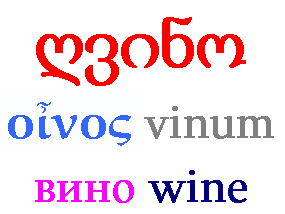by Joe Slater
22.12.2016. I’ve observed that the Greek and Hebrew words for wine, oinos and yayin, are similar. Does this imply that there was a Mediterranean trade in alcoholic beverages?
The making and consumption of grape wine (as opposed to such “wines” as date wine, rice wine, etc.) had spread all over the Mediterranean world and parts of Europe by an early historical period, and the similar words for wine that exist in many European and Semitic languages all point to a common source for both the beverage and its name. Thus, to take a small sample, besides Greek oinos and Hebrew yayin, we have Latin vinum, Russian вино, Lithuanian vynas, German Wein, Welsh gwin, Armenian gini, Georgian ghvino (ღვინო), and Amharic (the main language of Ethiopia) weyinina , to say nothing of such farther-flung cognates as Swahili mvinyo and Maori waina.
Many of these words are obviously borrowings. Ancient Russians, Lithuanians, Germans, and other central and northern European peoples did not grow grapes or make wine, and a widely disseminated word for it could not have originated in any of their languages, just as it could not have done so in Amharic, Swahili, or Maori. And although such a word theoretically could have originated in Latin vinum, Greek oinos,or Hebrew yayin, since ancient Italy, Greece, and Palestine were all grape-growing and wine-making regions, this, too, is unlikely, because the earliest grape cultivation and wine production that historians can point to took place in the Caucasus.
The oldest wine-making site discovered anywhere in the world thus far is in the Kvemo Kartli region of southeast Georgia, where clay vessels containing grape seeds and vine dust, dated to about 6,000 BCE, have been unearthed. It is probable, therefore, that it was Georgian, neither an Indo-European nor a Semitic language, that gave the world wine and a word for it, both of which spread in tandem.
This leaves us with three possibilities:
(1) Wine and its manufacture traveled from the Caucasus to southern Europe and the eastern Mediterranean basin at roughly the same time, so that oinos and yayin are independently descended from an ancient form of modern Georgian ghvino (ღვინო), either directly or through other, mediating languages.
(2) Wine reached southern Europe from the Caucasus first and traveled from there to the eastern Mediterranean, so that yayin may descend from oinos.
(3) Wine reached the eastern Mediterranean from the Caucasus first and traveled from there to southern Europe, so that oinos may indeed descend from yayin.
To the best of my knowledge, all of this remains an open question. Perhaps it will eventually be settled by the linguists and archaeologists, perhaps not. There’s really no rush to find out. Whether you would rather wash down your steak with a Greek agiorgitiko or an Israeli cabernet sauvignon doesn’t have much to do with it.
Source (abridged)
Win FREE bottle of organic white wine in Win!Wine Lottery: Just write a comment to this photo. Happy holidays!
22.12.2016. I’ve observed that the Greek and Hebrew words for wine, oinos and yayin, are similar. Does this imply that there was a Mediterranean trade in alcoholic beverages?
The making and consumption of grape wine (as opposed to such “wines” as date wine, rice wine, etc.) had spread all over the Mediterranean world and parts of Europe by an early historical period, and the similar words for wine that exist in many European and Semitic languages all point to a common source for both the beverage and its name. Thus, to take a small sample, besides Greek oinos and Hebrew yayin, we have Latin vinum, Russian вино, Lithuanian vynas, German Wein, Welsh gwin, Armenian gini, Georgian ghvino (ღვინო), and Amharic (the main language of Ethiopia) weyinina , to say nothing of such farther-flung cognates as Swahili mvinyo and Maori waina.
Many of these words are obviously borrowings. Ancient Russians, Lithuanians, Germans, and other central and northern European peoples did not grow grapes or make wine, and a widely disseminated word for it could not have originated in any of their languages, just as it could not have done so in Amharic, Swahili, or Maori. And although such a word theoretically could have originated in Latin vinum, Greek oinos,or Hebrew yayin, since ancient Italy, Greece, and Palestine were all grape-growing and wine-making regions, this, too, is unlikely, because the earliest grape cultivation and wine production that historians can point to took place in the Caucasus.
The oldest wine-making site discovered anywhere in the world thus far is in the Kvemo Kartli region of southeast Georgia, where clay vessels containing grape seeds and vine dust, dated to about 6,000 BCE, have been unearthed. It is probable, therefore, that it was Georgian, neither an Indo-European nor a Semitic language, that gave the world wine and a word for it, both of which spread in tandem.
This leaves us with three possibilities:
(1) Wine and its manufacture traveled from the Caucasus to southern Europe and the eastern Mediterranean basin at roughly the same time, so that oinos and yayin are independently descended from an ancient form of modern Georgian ghvino (ღვინო), either directly or through other, mediating languages.
(2) Wine reached southern Europe from the Caucasus first and traveled from there to the eastern Mediterranean, so that yayin may descend from oinos.
(3) Wine reached the eastern Mediterranean from the Caucasus first and traveled from there to southern Europe, so that oinos may indeed descend from yayin.
To the best of my knowledge, all of this remains an open question. Perhaps it will eventually be settled by the linguists and archaeologists, perhaps not. There’s really no rush to find out. Whether you would rather wash down your steak with a Greek agiorgitiko or an Israeli cabernet sauvignon doesn’t have much to do with it.
Source (abridged)
Win FREE bottle of organic white wine in Win!Wine Lottery: Just write a comment to this photo. Happy holidays!




No comments:
Post a Comment